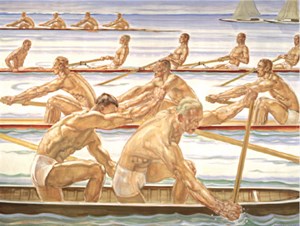
With the exhibition Art in the third reich – Seduction and distraction Museum Arnhem draws attention to the art from the period of the 'third reich', 1933-1945. What does it look like? Why was there, during a Nazi regime characterized by political violence, war and the Holocaust, so much focus on contemporary art? Did the artists support the regime, did the regime support the artists, or both?
Art in the third reich - Seduction and distraction offers an overview of fine arts created and displayed under the Nazi regime in Germany. The exhibition focuses on the period from 1937 to 1944, in particular the art displayed at the annual Große Deutsche Kunstausstellung in Munich. These exhibitions were organized by the state and attended en masse. Work by thousands of artists, who met the National Socialists’ stylistic and thematic criteria, was shown during this period. Their work was widely shown and purchased by individuals, the state and its leaders. The participating artists benefited greatly from this. But the state also benefited: art was used as an effective means of seducing the people with their ideology, while also providing a distraction from their criminal practices. How far did the Nazis go in controlling the art world?
Art in the third reich presents circa ninety paintings and sculptures by artists such as Claus Bergen, Paul Mathias Padua, Ria Picco-Rückert, Adolf Reich, Ivo Saliger, Josef Thorak, Else Wex-Cleemann, Adolf Wissel and Adolf Ziegler. Many of the works of art have not been on display since 1944. So now it's the first time since 1944 that these many different works of art come together in one retrospective exhibition and that an art museum in the Netherlands is paying attention to this charged period in German art history on this scale.
Museum Arnhem & art in a political context
Museum Arnhem specializes in the various forms of realism in the first half of the twentieth century. Art in the third reichis a further exploration of this realist art in a political context. In this exhibition Museum Arnhem wants to highlight the role of art in the third reich. How was art used for political gains? It's a period in art history that few people know about and has long been ignored in art history. Museum Arnhem wants to provide information about this blind spot and show how art was used to spread political ideas.
Main Image : Albert Janesch, Wassersport / Watersport / Water sports, 1936, 153 x 208 cm, Collection Deutsches Historisches Museum, Berlin, Photo: A. Psille, GM 98/254 – 98005245

ArtDependence Magazine is an international magazine covering all spheres of contemporary art, as well as modern and classical art.
ArtDependence features the latest art news, highlighting interviews with today’s most influential artists, galleries, curators, collectors, fair directors and individuals at the axis of the arts.
The magazine also covers series of articles and reviews on critical art events, new publications and other foremost happenings in the art world.
If you would like to submit events or editorial content to ArtDependence Magazine, please feel free to reach the magazine via the contact page.